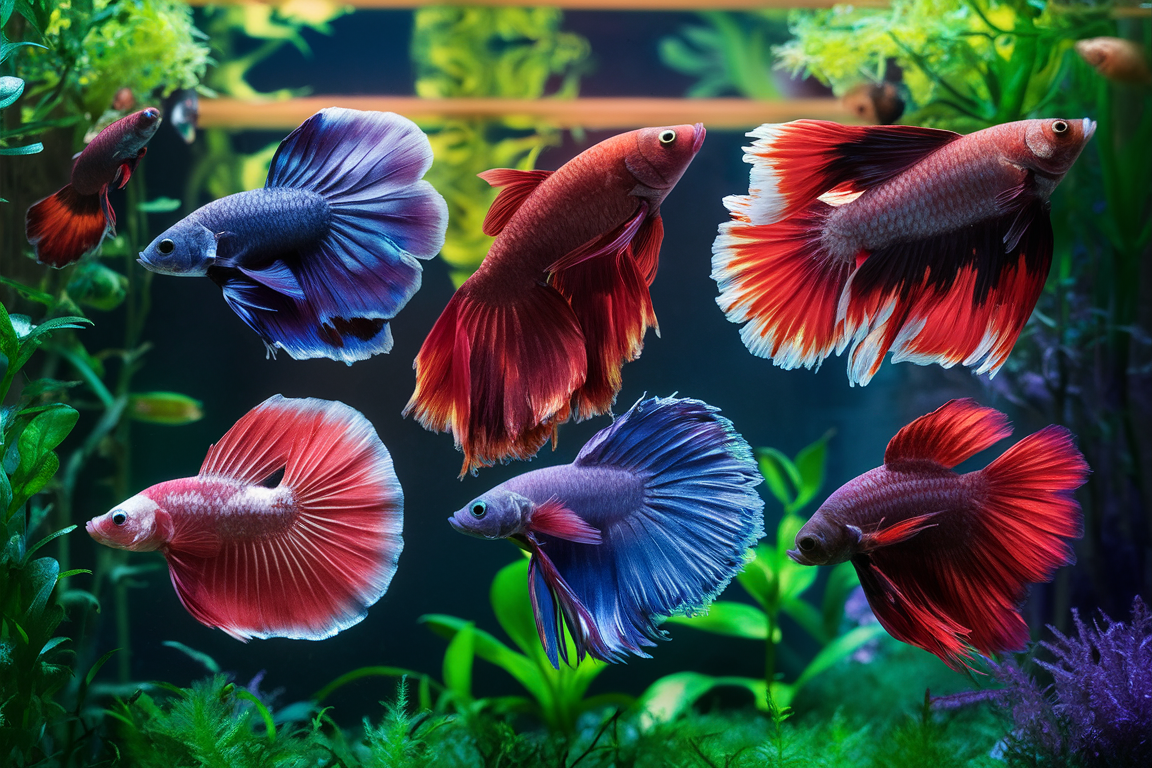Introduction: Unveiling the Diversity of Betta Fish
Betta fish, also known as Siamese Fighting Fish, are renowned for their vibrant colors, flowing fins, and captivating personalities. These captivating creatures come in a wide array of species, each with its own unique characteristics and charm. At Love My Koi, we’re passionate about exploring the fascinating world of betta fish, and this article will delve into the diverse betta fish species that make up this enchanting group.

The World of Betta Fish Species: A Journey of Discovery
Understanding Betta Fish: A Brief Overview
Betta fish belong to the genus Betta, which encompasses over 70 recognized species. These fish are native to Southeast Asia, particularly Thailand, Malaysia, and Indonesia. They are known for their labyrinth organ, which allows them to breathe air directly from the surface, making them adaptable to a variety of water conditions.
The Most Popular Betta Fish Species: A Showcase of Beauty
While there are many betta fish species, some stand out as favorites among aquarists:
- Betta splendens: The most common and widely recognized betta species, known for its long, flowing fins and vibrant colors.
- Betta imbellis: A smaller, more slender species with a distinctive “halfmoon” tail.
- Betta smaragdina: A beautiful species with a vibrant green coloration, often referred to as the “Emerald Betta.”
- Betta ocellata: A striking species with large, eye-like spots on its fins.
- Betta mahachaiensis: A rare and highly sought-after species with a distinctive “peacock” tail.
Exploring the Diversity of Betta Fish Species: A Deeper Dive
Beyond the most popular species, there are many other fascinating betta fish types, each with its own unique characteristics:
- Betta macrostoma: A large species with a distinctive, elongated snout.
- Betta channoides: A predatory species with a long, slender body and a large mouth.
- Betta rubra: A striking species with a vibrant red coloration.
- Betta albimarginata: A species with a distinctive white margin around its fins.
- Betta livida: A species with a unique, “ghost-like” appearance.
The Care of Betta Fish: A Guide to Healthy Living
Tank Setup for Betta Fish: Creating a Thriving Habitat
Betta fish are relatively easy to care for, but they require specific tank conditions to thrive:
- Tank Size: A 5-gallon tank is recommended for a single betta, while a 10-gallon tank can accommodate a small group.
- Water Parameters: Maintain a temperature of 78-82°F, a pH of 6.5-7.5, and low levels of ammonia, nitrite, and nitrate.
- Filtration: A sponge filter or a small hang-on filter is sufficient for a small tank.
- Substrate: Use a fine-grained substrate like sand or gravel.
- Plants: Live plants provide cover and enhance the aesthetic appeal of the tank.
- Decor: Add caves, driftwood, or other decorations to provide hiding places for the betta.
Feeding Betta Fish: A Balanced Diet for Optimal Health
Betta fish are carnivores and require a diet rich in protein:
- High-quality betta pellets: These pellets are specifically formulated for betta fish and provide the necessary nutrients.
- Live foods: Brine shrimp, bloodworms, and mosquito larvae are great sources of protein.
- Frozen foods: Frozen bloodworms, daphnia, and mysis shrimp are convenient alternatives to live foods.
Breeding Betta Fish: A Journey of Reproduction
Breeding betta fish can be a rewarding experience, but it requires careful planning and preparation:
- Choosing a Breeding Pair: Select a healthy male and female with vibrant colors and good finnage.
- Conditioning the Fish: Feed the fish a high-protein diet for several weeks before breeding.
- Setting Up a Breeding Tank: Use a separate tank with a shallow water level and a divider to separate the male and female.
- Introducing the Fish: Remove the divider and allow the male and female to interact.
- Spawning: The male will build a bubble nest, and the female will lay eggs.
- Care for the Fry: Remove the parents after spawning and care for the fry in a separate tank.
Frequently Asked Questions about Betta Fish Species
Can I keep different betta fish species together?
It’s generally not recommended to keep different betta fish species together, as they can be aggressive towards each other.
What are the signs of a healthy betta fish?
A healthy betta fish will have vibrant colors, clear fins, and a healthy appetite. It will also be active and responsive to its surroundings.
How do I know if my betta fish is sick?
If your betta fish is sick, it’s important to consult with a qualified veterinarian or aquarist for advice. Common betta diseases include fin rot, ich, and fungal infections.
What is the best way to clean a betta fish tank?
It’s best to perform partial water changes weekly, removing about 25% of the water and replacing it with fresh, dechlorinated water.
What is the best way to handle a betta fish?
It’s best to handle a betta fish gently, using a net or your hands with a soft touch. Avoid squeezing or dropping the fish.
Conclusion: A World of Color and Captivation
Betta fish species offer a stunning array of colors, shapes, and personalities. From the classic Betta splendens to the rare and exotic species, there’s a betta fish for every taste and preference. By understanding the care requirements of these fascinating creatures, you can enjoy their beauty and charm for years to come.

Related Posts
Colorful Freshwater Aquarium Fish: A Rainbow in Your Tank
Largest Koi Carp in the World: A Tale of Giants
Dragon Siamese Fighting Fish Female: A Guide to These Stunning Fish